Orbicular jasper is a variety of jasper, a type of chalcedony, known for its distinctive orb-like patterns. These patterns can vary in size, color, and arrangement, creating unique and visually striking stones. Orbicular jasper often displays concentric circles, spherical shapes, or irregular spots resembling orbs, hence the name “orbicular.”
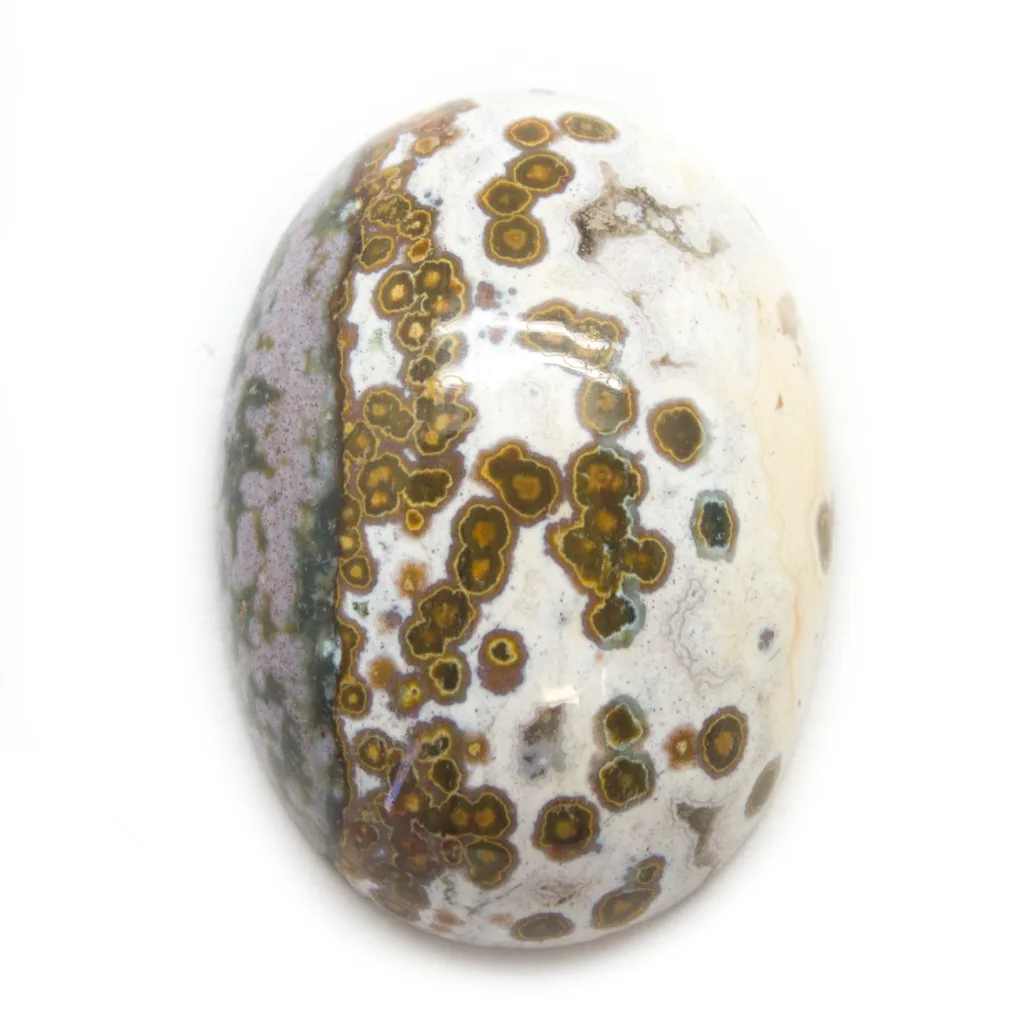
The base color of orbicular jasper can range from shades of red, brown, yellow, green, or blue, with the orbs typically contrasting in color. This stone is appreciated for its aesthetic appeal and is commonly used in jewelry making, lapidary arts, and as decorative objects.
Geological Formation: Orbicular jasper forms through a combination of geological processes, typically within volcanic or sedimentary environments. The formation begins with the deposition of silica-rich solutions or silica gel in cavities or fissures within rocks. Over time, these solutions undergo mineralization, resulting in the formation of chalcedony, which is a microcrystalline variety of quartz.
The distinctive orbicular patterns form due to the presence of various mineral impurities or inclusions within the silica solution. These impurities can include minerals such as hematite, goethite, chlorite, or other oxides and hydroxides, which crystallize in concentric layers around a nucleus or central point, giving rise to the orb-like structures.
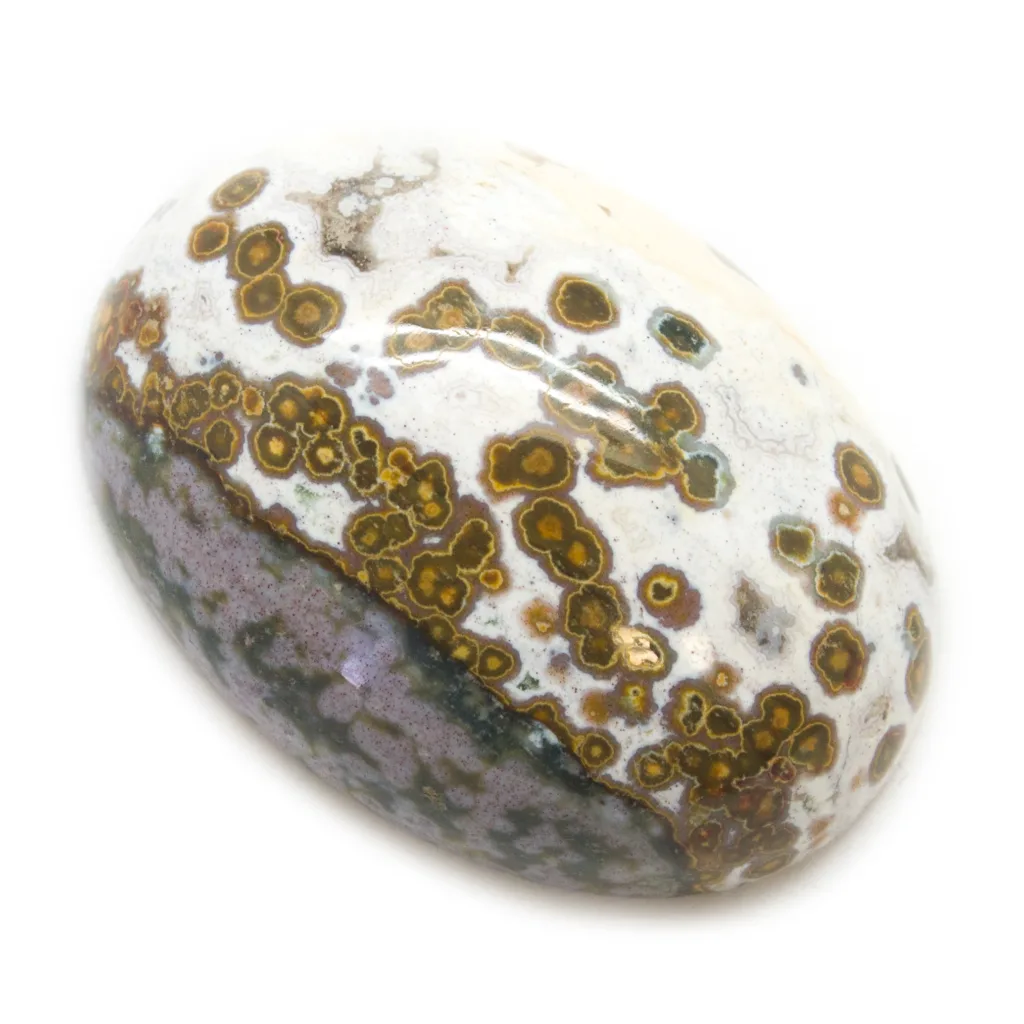
Significance and Uses: Orbicular jasper holds significance both as a decorative stone and for its perceived metaphysical properties. In metaphysical practices, orbicular jasper is believed to possess grounding and protective qualities, helping to balance energy and promote harmony. It is often associated with healing and emotional stability.
Overall, orbicular jasper stands out for its captivating appearance, geological intrigue, and cultural significance, making it a sought-after material in various industries and practices.
Physical Properties, Composition and Mineralogy
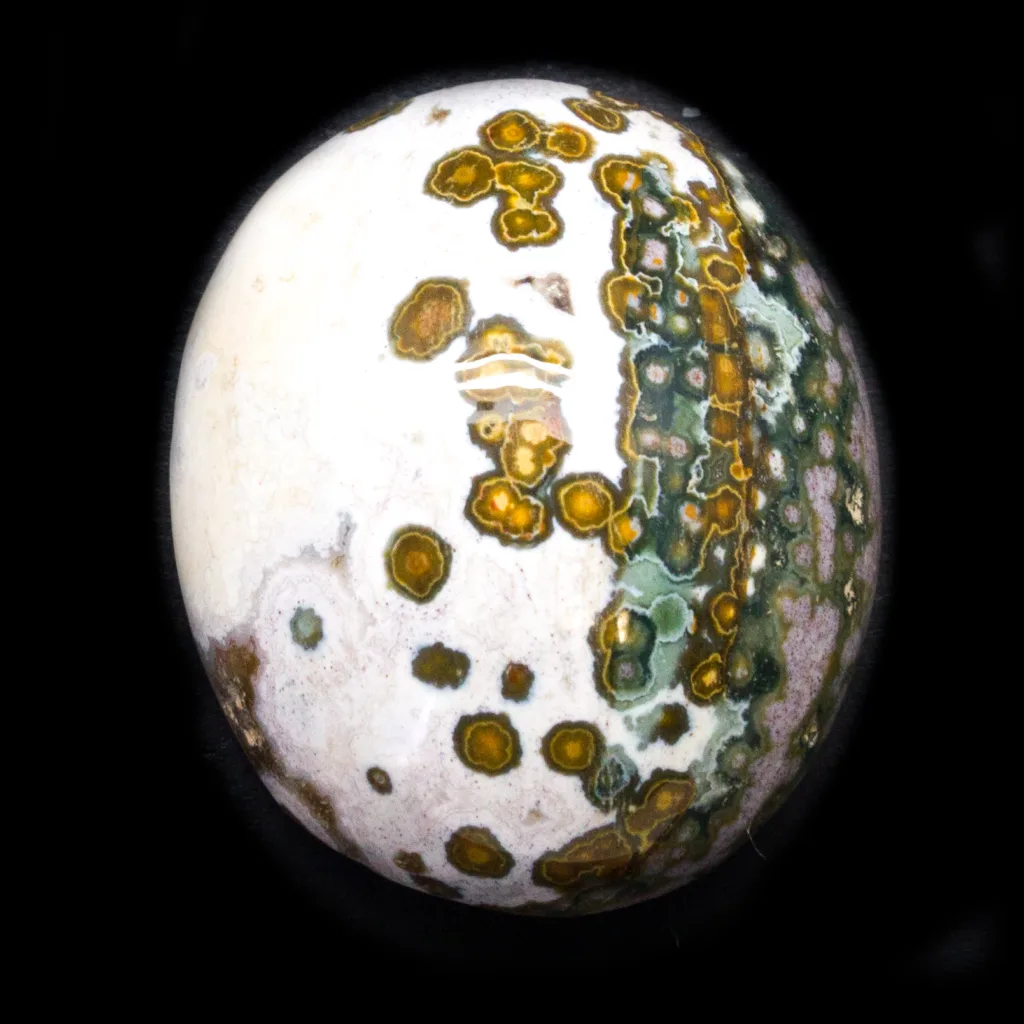
Physical Properties: Orbicular jasper, like other varieties of jasper, exhibits typical properties of chalcedony and quartz:
- Hardness: Orbicular jasper has a hardness of around 6.5 to 7 on the Mohs scale, making it relatively durable and suitable for use in jewelry and lapidary arts.
- Density: Its density ranges between 2.58 to 2.91 g/cm³, depending on its composition and porosity.
- Color: The base color of orbicular jasper can vary widely, including shades of red, brown, yellow, green, and blue, with contrasting orbicular patterns.
- Luster: It typically exhibits a waxy to vitreous luster when polished.
- Transparency: Orbicular jasper is generally opaque, though thin sections may display translucency.

Composition and Mineralogy: Orbicular jasper is primarily composed of microcrystalline quartz, specifically chalcedony, which forms through the precipitation of silica-rich solutions. The distinctive orbicular patterns arise from the presence of various mineral impurities or inclusions within the silica matrix. These impurities can include:
- Hematite: A common iron oxide mineral that imparts red to brown coloration to the orbs.
- Goethite: Another iron oxide mineral that contributes to brown or yellow hues.
- Chlorite: A green-colored mineral that may produce green orbs within the jasper.
- Other Oxides and Hydroxides: Depending on the specific geological conditions, other minerals such as limonite, magnetite, and other metal oxides or hydroxides may also be present, influencing the color and composition of the orbicular patterns.
The formation of orbicular jasper involves the gradual deposition and crystallization of these minerals around a central nucleus or point, resulting in the characteristic orb-like structures. The exact composition and mineralogy of orbicular jasper can vary significantly depending on the specific geological environment in which it forms, leading to a wide range of colors and patterns observed in different specimens.
Distribution and Occurrence
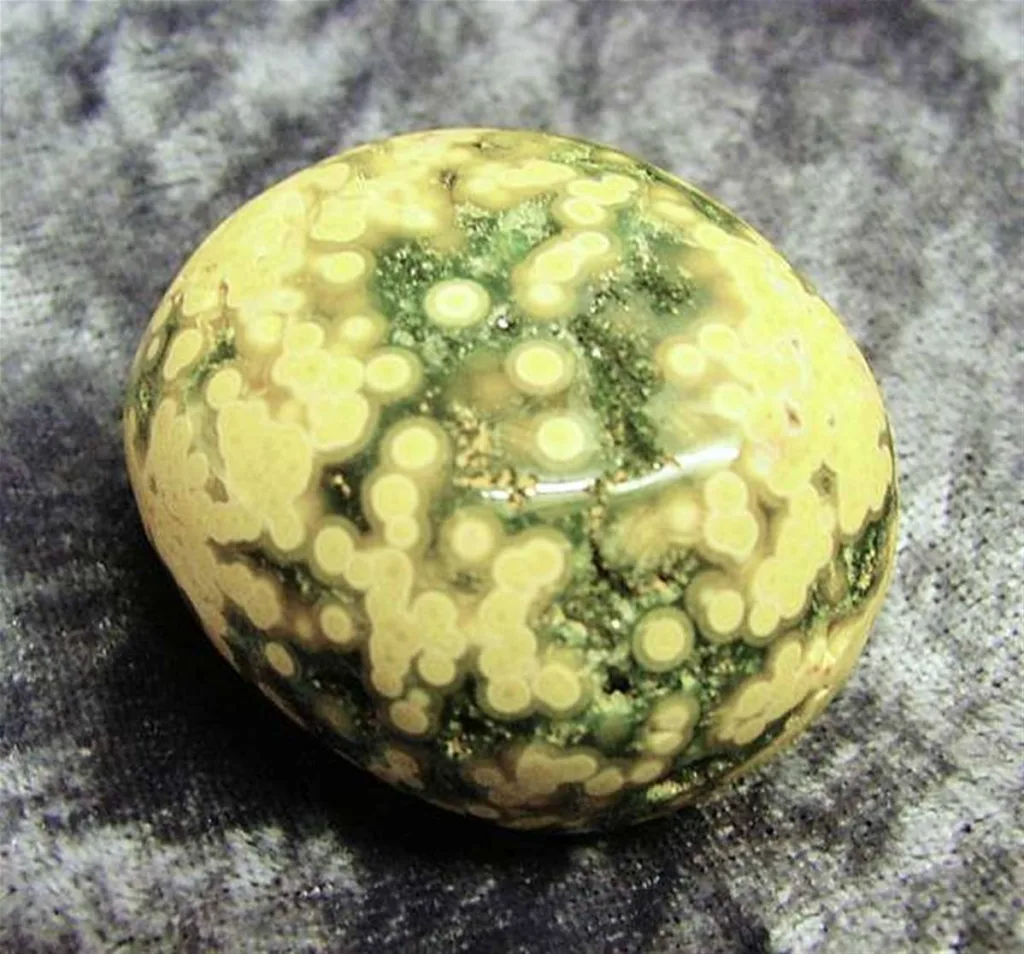
Orbicular jasper is found in various locations around the world, with each locality often exhibiting unique characteristics in terms of color, pattern, and composition. Some of the notable regions where orbicular jasper is known to occur include:
- Madagascar: Madagascar is renowned for its high-quality orbicular jasper, particularly from the Ambatofinandrahana region. The jasper from Madagascar often features vivid colors and distinct orb patterns, making it highly sought after by collectors and lapidaries.
- Mexico: Mexico is another significant producer of orbicular jasper, with deposits found in regions such as Jalisco and Chihuahua. Mexican orbicular jasper is known for its vibrant colors and intricate orbicular patterns, making it a popular choice for jewelry and lapidary work.
- Russia: The Ural Mountains in Russia are known to contain orbicular jasper deposits, particularly in the areas around the city of Yekaterinburg. Russian orbicular jasper often exhibits unique color combinations and intricate patterns, attracting interest from collectors and artisans.
- United States: Orbicular jasper can be found in several states across the United States, including Oregon, California, Idaho, and Washington. Oregon, in particular, is known for its Ocean Jasper, a type of orbicular jasper found along the coast, known for its distinctive circular patterns resembling ocean waves.
- South Africa: South Africa is home to orbicular jasper deposits, with notable occurrences in regions such as the Northern Cape Province. South African orbicular jasper exhibits a range of colors and patterns, adding to its appeal in the gem and mineral market.
- Australia: Western Australia is known to have deposits of orbicular jasper, with occurrences in areas such as the Kennedy Ranges. Australian orbicular jasper is prized for its rich colors and unique orb patterns, making it popular among lapidaries and collectors.
These are just a few examples of the regions where orbicular jasper can be found. The geological conditions and processes specific to each locality contribute to the diversity of orbicular jasper specimens observed worldwide. Orbicular jasper is valued not only for its aesthetic appeal but also for its geological and cultural significance, making it a sought-after material in the gem and mineral trade.
Orbicular Patterns

Orbicular patterns in orbicular jasper are distinctive features that contribute to the stone’s aesthetic appeal and uniqueness. These patterns typically consist of concentric circles, spherical shapes, or irregular spots resembling orbs, giving the stone its name. The orbicular patterns can vary widely in size, color, and arrangement, resulting in a diverse range of visual effects. Here are some common types of orbicular patterns found in orbicular jasper:
- Concentric Circles: This is one of the most common orbicular patterns observed in orbicular jasper. It consists of concentric circles of different colors radiating outward from a central point. The circles may vary in size and intensity, creating a captivating visual effect reminiscent of ripples in water or the rings of a tree.
- Spherical Shapes: Some specimens of orbicular jasper exhibit spherical or rounded shapes scattered across the surface of the stone. These orbs may be uniform in size or vary in size, creating a dynamic and visually striking pattern. The spherical shapes can resemble bubbles, marbles, or planets, adding to the stone’s allure.
- Irregular Spots: In addition to concentric circles and spherical shapes, orbicular jasper may display irregular spots or blotches distributed unevenly throughout the stone. These spots can vary in size, shape, and color, creating a more abstract and organic-looking pattern. The irregular spots add texture and depth to the stone’s appearance, enhancing its visual interest.
- Color Variations: Orbicular jasper exhibits a wide range of colors, and the orbicular patterns often feature contrasting colors that highlight the distinctive shapes and arrangements. For example, red orbs may stand out against a background of green or brown, creating a vibrant and eye-catching contrast. The interplay of colors adds dimensionality and complexity to the stone’s overall appearance.
- Matrix: Orbicular jasper is often found embedded within a matrix of other minerals or rock material. The matrix can vary in color and texture, providing a backdrop against which the orbicular patterns stand out. The matrix adds context to the stone’s geological origins and may contribute to its overall aesthetic appeal.
Overall, the orbicular patterns found in orbicular jasper are a testament to the intricate processes of mineral formation and deposition. Each specimen is unique, with its own combination of colors, shapes, and textures, making orbicular jasper a highly prized and sought-after material in the world of gemstones and lapidary arts.
Uses and Applications
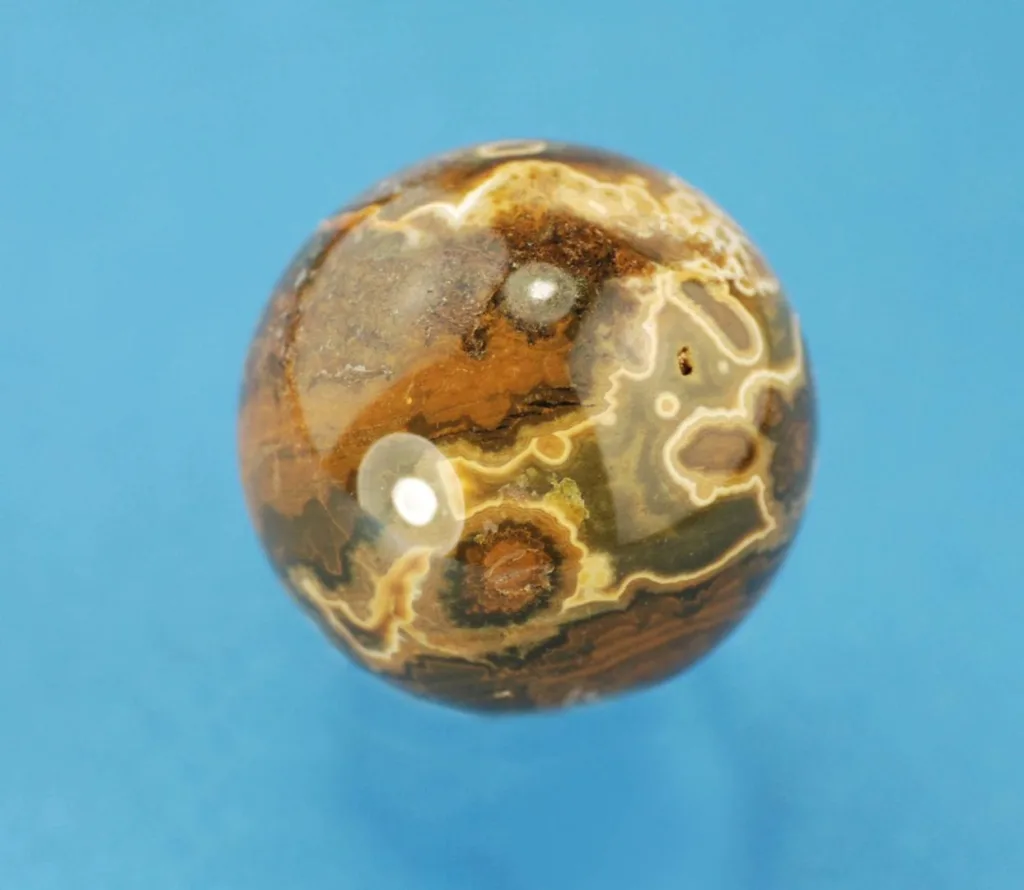
Orbicular jasper is a versatile material that finds various uses and applications across different industries and practices. Its aesthetic appeal, unique patterns, and perceived metaphysical properties make it sought after for a range of purposes:
- Jewelry Making: Orbicular jasper is commonly used in jewelry making, where it is fashioned into cabochons, beads, pendants, and other ornamental pieces. Its distinctive orbicular patterns and vibrant colors make it a popular choice for creating eye-catching jewelry designs. Orbicular jasper jewelry is often appreciated for its natural beauty and individuality, as each piece is unique.
- Lapidary Arts: Lapidaries, artisans skilled in cutting and polishing gemstones, often work with orbicular jasper to create decorative objects and sculptures. The stone’s hardness and durability make it suitable for carving into various shapes and forms, allowing for creative expression in art and craftsmanship. Orbicular jasper may be sculpted into spheres, eggs, figurines, and other intricate designs, showcasing its aesthetic and geological characteristics.
- Decorative Objects: Orbicular jasper is used to craft decorative objects for interior design and home decor purposes. Polished orbs, slabs, and tiles of orbicular jasper can be incorporated into countertops, tabletops, wall panels, and other architectural elements to add a touch of natural beauty and sophistication to residential and commercial spaces.
- Metaphysical and Healing Practices: In metaphysical and spiritual traditions, orbicular jasper is believed to possess various healing properties and energetic qualities. It is often used as a grounding stone that promotes stability, balance, and emotional well-being. Orbicular jasper is said to aid in meditation, visualization, and spiritual growth, helping individuals connect with the Earth’s energy and find inner harmony.
- Collecting and Display: Collectors of gemstones and minerals often seek out unique specimens of orbicular jasper for their personal collections. Specimens with particularly striking patterns or colors are highly valued among collectors and enthusiasts. Orbicular jasper specimens may be displayed in mineral collections, museums, and educational exhibits to showcase their geological beauty and diversity.
- Gifts and Souvenirs: Due to its natural beauty and symbolic significance, orbicular jasper is sometimes given as a gift or souvenir to commemorate special occasions or events. Polished stones, jewelry pieces, or decorative objects made from orbicular jasper can serve as meaningful and memorable gifts that convey appreciation, connection to nature, and positive energy.
Overall, orbicular jasper serves both aesthetic and practical purposes, enriching various aspects of human life through its beauty, versatility, and inherent qualities. Whether as a piece of jewelry, a work of art, or a spiritual tool, orbicular jasper continues to captivate and inspire people around the world.




































